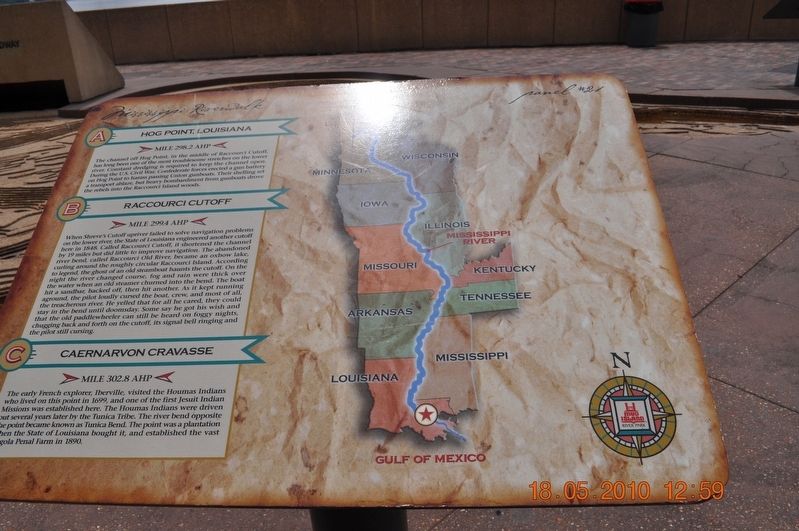Memphis in Shelby County, Tennessee — The American South (East South Central)
Hog Point, Louisiana/Raccourci Cutoff/Caernarvon Crevasse
Panel #21 Mississippi Riverwalk
Inscription.
A) Hog Point, Louisiana
Mile 298.2 AHP
The channel off Hog Point, in the middle of Raccourci Cutoff, has long been one of the most troublesome stretches on the lower river. Constant dredging is required to keep the channel open. During the U.S. Civil War, Confederate forces erected a gun battery on Hog Point to harass passing Union gunboats. Their shelling set a transport ablaze, but heavy bombardment from gunboats drove the rebels into the Raccourci Island woods.
B) Raccourci Cutoff
Mile 288.4 AHP
When Shreve’s Cutoff upriver failed to solve navigation problems on the lower river, the State of Louisiana engineered another cutoff here in 1848. Called Raccourci Cutoff, it shortened the channel by 19 miles but did little to improve navigation. The abandoned river bend, called Raccourci Old River, became an oxbow lake, curling around the roughly circular Raccourci Island. According to legend, the ghost of an old steamboat haunts the cutoff. On the night the river changed course fog and rain were thick over the water when an old steamer churned into the bend. The boat hit a sandbar, backed off, then hit another. As it kept running aground, the pilot loudly cursed the boat crew and most of all, the treacherous river. He yelled that for all he cared, they could stay in the bend until doomsday. Some say he got his wish and that the old paddlewheeler can still be heard on foggy nights, chugging back and forth on the cutoff, its signal bell ringing and the pilot still cursing.
C) Caernarvon Crevasse
Mile 302.8 AHP
The early French explorer, Iberville, visited the Houmas Indians who lived on this point in 1699, and one of the first Jesuit Indian Mission was established here. The Houmas Indians were driven out several years later by the Tunic Tribe. The river bend opposite the point became known as Tunica Bend. The point was a plantation when the State of Louisiana bought it, established the vast Penal Farm in 1890.
Erected by Mississippi Riverwalk. (Marker Number 21.)
Topics. This historical marker is listed in these topic lists: Native Americans • War, US Civil • Waterways & Vessels.
Location. 35° 8.968′ N, 90° 3.507′ W. Marker is in Memphis, Tennessee, in Shelby County. Marker can be reached from Island Drive, 0.8 miles south of West A.W. Willis Avenue. Located in Mud Island River Park. Touch for map. Marker is at or near this postal address: 125 N Front St, Memphis TN 38103, United States of America. Touch for directions.
Other nearby markers. At least 8 other markers are within walking distance of this marker. The Mississippi Riverwalk (here, next to this marker); Ohio River (here, next to this marker); Cairo, Illinois (here, next to this marker); Islands No. 2, 3, and 4 / Fort Jefferson, Kentucky / Bird’s Point, Missouri (here, next to this marker); Island No. 5 (Wolf Island)/Belmont, Missouri/Columbus, Kentucky (here, next to this marker); Donaldson Point, Missouri/Island No. 8/Hickman, Kentucky/Dorena Crevasse (here, next to this marker); New Madrid, Missouri/Cates Casting Field/Island No. 10 (here, next to this marker); Tiptonville, Tennessee/Bixby Towhead (here, next to this marker). Touch for a list and map of all markers in Memphis.
Also see . . . The First French Settlements, 1699–1713. 64 Parishes website entry:
French Crown officials paid little attention to the needs of Lower Louisiana during the early 1700s because of their involvement in the War of Spanish Succession (1701–1714). Lacking official support, Iberville and his elite associates were unable to implement the conventional French mercantilist practice of exploiting natural resources (furs, minerals, cash crops) from colonial territories. To compensate for supply shortages, French colonists relied heavily on the slave labor and agricultural acumen of neighboring Native American groups. To protect against the slave raids and military advances of British-allied tribes such as the Creek, Native American villages in the vicinity of Mobile developed close working relationships with the French. The Choctaw and Chickasaw were especially influential in how the French developed strategies to defend against British encroachment throughout frontier areas east of the Mississippi River. The close interconnectedness of Native Americans and Europeans during this early colonization phase convinced historian Daniel Usner to describe French colonial Louisiana as a “frontier exchange economy” influenced by local and regional networks as well as transatlantic and global movements. (Submitted on March 14, 2018, by Sandra Hughes Tidwell of Killen, Alabama, USA.)
Credits. This page was last revised on June 23, 2022. It was originally submitted on March 14, 2018, by Sandra Hughes Tidwell of Killen, Alabama, USA. This page has been viewed 329 times since then and 31 times this year. Photo 1. submitted on March 14, 2018, by Sandra Hughes Tidwell of Killen, Alabama, USA. • Bernard Fisher was the editor who published this page.
Editor’s want-list for this marker. Wide shot of marker and its surroundings. • Can you help?
